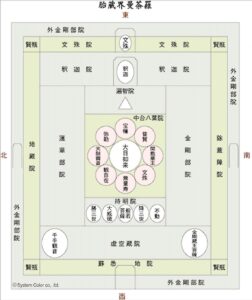Ro Tenmae: Host and Guest

Tea presentation with the ro, 炉, hearth, as seen from the vantage of the shō-kyaku, 正客, correct-guest, in a yo-jo-han, 四畳半, four-mat-half Tearoom. The cha-dōgu, 茶道具, tea-tool-way, arrangement with fire in the ro on the left, and water in the mizu-sashi, 水指, water-indicate, on right.
The cha-dō-gu, 茶道具, tea-way-tools include an Amida-dō kama, a large ceramic mizusashi by Makoto Yabe, with a black-lacquered tray as a lid, displayed on an ōita, cut from the board for using the ro, a Hagi chawan, and Korean porcelain futaoki for the kettle lid. The flower is displayed in a bamboo hanaire hung from a moveable hook in a cedar wood sui-hatsu, 垂撥, hang–plectrum. Not every room has a tokonoma.
Ga-ran-dō, 伽蘭洞, Attend-orchid-cave, my Tearoom, has tatami tables that I created in the 1990s. The tables can be moved to create various arrangements. The picture above approximates the partial arrangement of a yo-jō-han, 四畳半, four-mat-half, Tearoom. The view of the ten-mae-za, 点前座, offer-fore seat, is from the vantage of the shō-kyaku, 正客, correct-guest.
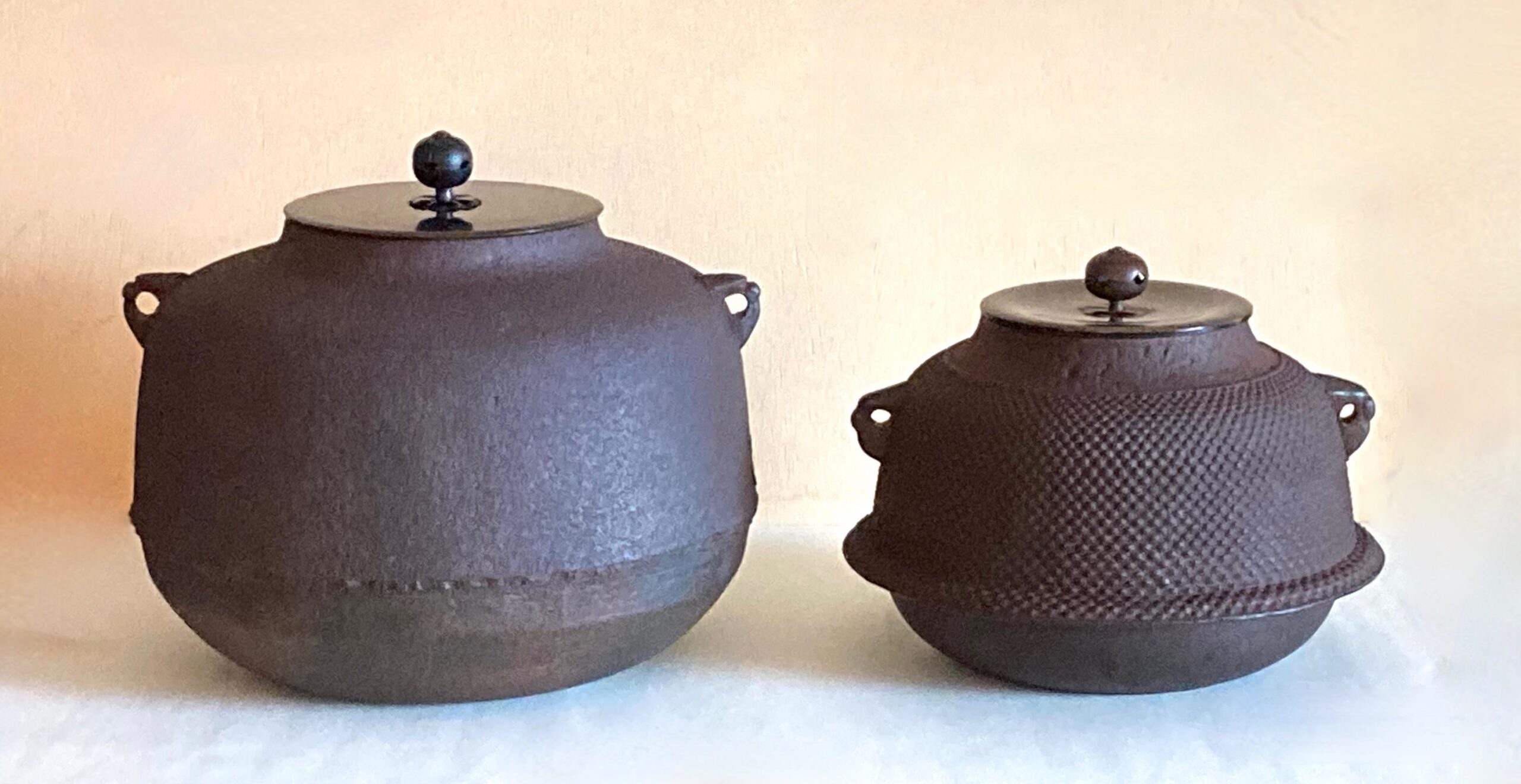
Left: Amida-dō gama, 阿弥陀堂釜, Praise-increasingly-steep-hall kettle, tetsu, 鉄, iron, by Kiku-chi Masa-toyo, 菊地政豊, Chrysanthemum-ground Govern-excellent; diam. 6 sun kujira-jaku, used with the ro: this type of kettle was originally used with temple furo. Right: kama, 釜, kettle, tetsu, 鉄, iron, by Kana-mori Jō-ei, 金森浄栄, Gold-woods Pure-splendor, diam. excluding the hane, 羽, wing, 6 sun kane-jaku, used with the furo. The number six is symbolic of Water and Infinity in Time.
When using the fu-ro, 風炉, wind-hearth, fire is on the left, and water, in the mizu-sashi, 水指, water-indicate, is on the right. This is called hon-ga-tte, 本勝手, origin-prevail-hand. Originally, in the time of Rikyū, the arrangement of utensils had the furo with its’ fire on the right, and water in the mizusashi on the left. This arrangement was on the east side of the yojōhan chashitsu. These utensils were used in temples, and with large furo and kama. When tatami completely covered the floor, the large temple furo and kama were deemed too big for tatami, so that the furo was reduced in size, and a smaller kama was created for newer smaller furo. This prompted Tea people to make use of the precious and venerated large kama, and thus they created the ro for its use.
I believe that prior to Sen no Rikyu’s time, in original temple style tea, having the ro fire on the left in the gyakugatte arrangement with utensils in the East, made certain movements awkward, and opening the ro on the opposite West side of the Tearoom was a major change. Moving the fire and the utensils to the West side of the Tearoom, created what is now the present version of hongatte. Ladling hot water from the kama on the left, was and is awkward, which may have encouraged the mirror-like change of the utensils’ location.
In February, Urasenke, in a sense, reverts to having the ro with its fire on the left and water on the right. This arrangement is called now called gyaku-ga-tte, 逆勝手, opposite-prevail-hand. In the present hongatte with ro, from the vantage of the shōkyaku, the relationship of fire on the left and water on the right is like the original temple hongatte. Thus, the location of the shōkyaku in what is now referred to as gyakugatte, is the seat of the teishu in the original temple hongatte. All of these changes affirm a strong Buddhist influence on Chanoyu.
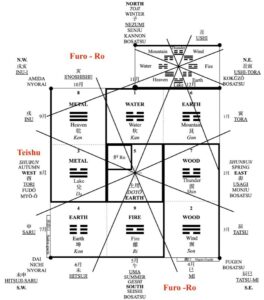
According to Asian geomancy and cultural identification, the world is governed by the seasons, directions, etc. which have their basis in the Asian zodiac, the jū-ni-shi, 十二支, ten-two-branches. The animals are associated with the years, months, days, hours, etc. The Asian zodiac animals are: Ne, 子, Rat; Ushi, 丑, Ox; Tora, 虎, Tiger; U, 卯, Hare; Tatsu, 辰, Dragon; Mi, 巳, Snake; Uma, 午, Horse; Hitsuji, 未, Ram; Saru, 申, Monkey; Tori, 酉, Chicken; Inu, 戌, Dog; I, 亥, Wild Boar. Each of the animals has a Buddhist guardian. This is manifest in the yo-jō-han cha-shitsu, 四畳半茶室, four-mat-half tea-room. The Tearoom is oriented to the north with the tokonoma in the north wall toward the east. The host prepares tea along the western wall facing north, and the guests sit along the east wall facing west.
The north is identified with the Asian zodiac sign of the Rat, Ne, 子, which is guarded by Sen-jū Kan-non Bo-satsu, 千手観音菩薩, Thousand-hand See-sound Grass-Buddha. The other animal signs have their guardians. The exception is the corners of the room have two animals with one guardian. For example the northeast is marked with the signs of the Ushi, 牛, Ox, and Tora, 寅, Tiger, which together form the sign Ushi-Tora, 艮, which means mountain, These signs are guarded by Ko-kū-zō Bo-satsu, 虚空蔵菩薩, Empty-Void-keep Grass-buddha.
The ro ten-mae, 炉點前, hearth offer-fore, as seen from the perspective of shōkyaku is also the perspective of Ko-kū-zō Bo-satsu, 虚空蔵菩薩, Empty-void-keep Grass-buddha, in the Northeast corner of the yojōhan. In a very formal Tea presentation, the imae of the teishu is directed toward the Buddhist influenced kake-jiku, 掛軸, hang-scroll, in the tokonoma, is the area which is protected by Sen-ju Kan-non Bo-satsu, Thousand-hand See-sound Grass-buddha. The Northeast is the source of harsh winds, and is called the ki-mon, 鬼門, demon-gate. The shō-kyaku, 正客, via their physical location acts on behalf of Kokūzō. Because the host’s imae is in direct relation to the ro, Kokūzō becomes, metaphorically, a mirror for the tei-shu, 亭主, house-master. In the present hongatte arrangement with the ro on the right, the teishu is directed toward Kokūzō, who is a manifestation of Dainichi. From the vantage of the shōkyaku, who is directed towards teishu, shōkyaku sees the mirroring of Dainichi. The teishu at the start of the Tea presentation, holds up the hi-shaku, 柄杓, handle-ladle, in what is called kagami bi-shaku, 鏡柄杓, mirror handle-ladle.
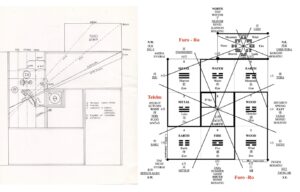
Left: diagram of a yo-jō-han cha-shitsu, 四畳半茶室, four-mat-half tea-room, with lines indicating the direction the tei-shu, 亭主, house-master, assumes when preparing Tea of various levels of formality. Right; diagram of a yojōhan chashitsu showing the possible identifications with directions, seasons, lunar and solar months, Buddhist deities, signs from the Eki-kyō, I Ching, 易経, Change-sutra, etc.
The pattern of layout of tatami in a yojōhan is like the manji, 卍, the ancient and auspicious symbol of the svastika, स्वस्तिक, which in a Sanskrit word meaning ‘conducive to well-being’. However, the yojōhan tatami arrangement is the reverse manji, 卐. The ‘manji’ is also written, 万字, meaning ‘ten thousand’-character. The manji 卍 is shown at times on the chest of images of Amida, The Buddha of Compassion. The manji symbol has often been used to emulate or describe the footprints of the Buddha. It can be configured 卍 as facing left, or moving counterclockwise, this is to symbolize night and Compassion. It can also be configured 卐 as facing right, or moving clockwise, this is to symbolize surya, the sun, and Wisdom. The latter manji is the pattern of the tatami layout of Dō-jin-sai, 同仁斎, Equal-benevolence-abstain, the study and Tearoom of the Tō-gu-dō, 東求堂, East-plea-hall, at Gin-kaku-ji, 銀閣寺, Silver-pavilion-temple. The Tōgudō was built for the worship of Amida Nyorai and the study of Amida’s western paradise of Jō-dō, 浄土, Pure-land. A way to remember the difference between the two manji is: S 卐 for Smart, and Z 卍 for Zen.
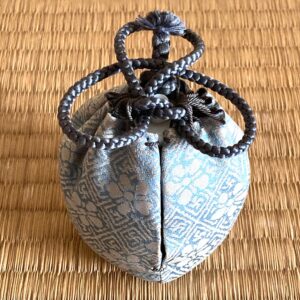
Shi-fuku, 仕覆, serve-cover, for a cha-ire, 茶入, tea-receptacle, silk fabric with a pattern called Fuji-tane Don-su, 藤種緞子, Wisteria-seed Damask-of, which depicts manji among ume, 梅, prunus, flowers. The cord may evoke the lasso of Fudō: shown with the cord indicating the container is empty of tea powder. The Rikyu Maru-tsubo cha-ire, 丸壺茶入, Round-jar tea-receptacle, had a shifuku with this pattern.
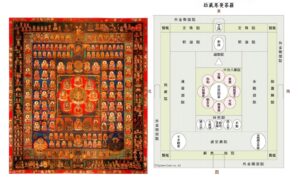
For this study, a few deities are described. In the diagram the horizontal area near the bottom including the two white circles is the Ko-kū-zō-in, 虚空蔵院, Empty-void-keep-sub temple. In the mandara, Kokūzō is depicted in the center of the area flanked by nineteen smaller figures. This location is approximately the same as the place of the teishu in a yojōhan chashitsu.
The deity in the white circle on the bottom left of the diagram is Sen-ju Kan-non Bo-satsu, 千手観音菩薩, Thousand-hand See-sound Grass-buddha. In many visual depictions an image of Amida adorns Kannon’s crown. This location in the yojōhan chashitsu correlates to where Tea utensils are arranged. The deity in the white circle on the bottom right of the diagram is Kon-gō-za-ō Bo-satsu, 金剛蔵王菩薩, Gold-strength-keep-king Grass-buddha, who is blue-black in color, with 16 faces, 108 arms, and is depicted holding a single-pronged vajra, a trident, a wheel, a sword, a jewel, etc.
In identifying the yojōhan chashitsu with the Taizōkai Mandara, the area where the guests sit in the yojōhan is in the East, guarded by Mon-ju Bo-satsu, 文殊菩薩, Literate-exceptional Grass-buddha. In the Taizōkai Mandara, Monju is the guardian of the East, which is his own realm, the Mon-ju-in, 文殊院, Literate-exceptional-sub temple. In the diagram, the Monjuin is the light green area across the top, which is identified as East, just below the light gray area. Monju himself is located in the white oval in the center of his realm.
Vimalakirti Yuima, follower of the historical Buddha was advised to consult Manjushri (Monju) regarding the seating of the noble visitors to his ten-foot square hut (precursor of the yojōhan). In the diagram, the area below the Monjuin is the Sha-ka–in, 釈迦院, Explain-(sound)-sub temple, the realm of the historical Buddha. Shaka is depicted in the white oval in the center of his realm. Monju and his counterpart Fu-gen Bo-satsu, 普賢菩薩, Universal-wisdom Grass-buddha, are often depicted accompanying Shaka, the historical Buddha. Monju is also depicted in the diagram in the centered large white circle to the lower right of Dainichi, who is the central image of the mandara and the diagram.
Some supreme Buddhist deities have wrothful manifestations that act on the gods’ behalf. Dai-nichi, 大日如来, Great-sun Like-become, the universe made manifest, has several manifestations, and two are of particular prominence: Ko-kū-zō Bo-satsu, 虚空蔵菩薩, Empty-void-keep Grass-buddha, and Fudō Myō-ō, 不動明王, No-move Bright-king.
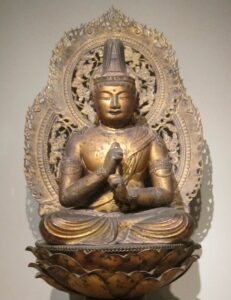
Dainichi is all pervading! With hands intertwined, he does not handle things. Dainichi Nyorai, Kokūzō Bosatsu, and Fudō Myō-ō are three different developments of Buddhist deities, and may be classified as Shin, 真, True, Gyō, 行, Transitional, semi-formal, and Sō, 草, Grass, informal. Nyorai, 如来 in Sanskrit is Tathagata, तथागत, a perfected one who is fully enlightened. Dainichi, in Sanskrit is Maha Vairocana, Great Illuminator, Dainichi is the ultimate concept in many forms of Buddhism. He is everything and nothing in the universe.
In Buddhist formality, a nyorai may be classified as Shin, 真, True. Dainichi is the guardian of the southwest, and the Asian zodiac signs of Hitsuji, 未, Ram, and Saru, 申, Monkey, are combined to form the Eki-Kyō, I Ching, 易経, Change-sutra, sign of Kon, 坤, Earth, marked with the trigram ☷. This location is identified with the physical element of Earth, on the fumi-komi tatami, 踏込畳, step-into mat. In the realm of Chanoyu, the tei-shu, 亭主, house-master may be identified as Dainichi at the onset of the Tea presentation.
When the teishu first prepares to greet the guests in the Tearoom, while seated on the floor in the mizuya, he or she opens the door of the Tearoom, and everyone bows. The shōkyaku bids the teishu to enter the Tearoom, and the teishu slides into the room as Dainichi. Later, when entering the Tearoom to present Tea, he or she walks into the room, and is thus transformed into Dainichi’s judging, wrothful manifestation of Fudō, in service to the guests. The teishu’s entrance and location in the Tearoom is in the southwest corner. The southwest corner post of the Tearoom marks Ri-sshu, 立秋, Start-autumn.
When the teishu first meets the guests, representing Dainichi, he or she greets the shō-kyaku, 正客, correct-guest, and in a theoretical sense, is greeting Kokūzō Bosatsu, who is another of Dainichi’s manifestation. It should be remembered that Dainichi is everything in the universe. As are each of us human beings.
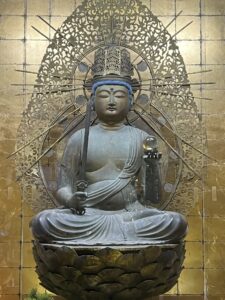
A Bo-satsu, 菩薩, in Sanskrit is Bodhisattva, तथागत, and is one who has reached enlightenment, but vows to save all sentient beings before becoming a buddha. A Bosatsu may be classified as Gyō, 行, transitional, and often acts on behalf of a Nyorai. Kokūzō is the ‘empty’ Void of the Universe, and is the Buddha of cosmic wisdom. He is the guardian of the northeast and is the protector of the Asian zodiac signs of Ushi, 丑, Ox, and Tora, 寅, Tiger, which together form the Ekikyō trigram sign of Gon, 艮, Mountain, is marked with the trigram, ☶. This location is identified with the physical element of Earth, which is the same element as the southwest location of Dainichi, both are aspects of the Universe. The han-jō, 半畳, half-tatami, center of the yojōhan Tearoom, and the location of the ro, are also identified with Dainichi and Earth.
In Chanoyu, Kokūzō may be identified as the shō-kyaku, 正客, correct-guest, whose location is in the northeast corner of the Tearoom. The northeast corner post of the Tearoom marks Ri-sshun, 立春, Start-spring.
Kokūzō holds the San-ko-ken, 三鈷剣, Three-cobalt-sword, with his right hand, and on his left hand he holds the hō-ju, 宝珠, treasure-jewel, supported on a hasu no hana, 蓮の花, lotus’s flower. In identifying the guest as a representative of Kokūzō, the sword may be identified with the guest’s sen-su, 扇子, fan-of, or a stick or blade used to cut the sweet offered by the teishu.
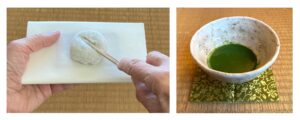
The hōju may represent the o-ka-shi, 御菓子, hon.-sweet-of, and the lotus, hasu, 蓮, may also represent the kai-shi, 懐紙, heart-paper. The kaishi may represent both the Heart Sutra and the Lotus Sutra. The same jewel and lotus may be imagined with the cha-wan, 茶碗, tea-bowl, supported on a kobukusa, 古帛紗, old-cloth-gauze.
Cha-wan, 茶碗, tea-bowl, Hagi-yaki, 萩焼, Bush clover-fired, by U-da-gawa Sei-koku, 宇田川聖谷, Heaven-field-river Holy-valley, Yama-guchi-ken, 山口県, Mountain-opening-pref. Ko-buku-sa, 古帛紗, old-cloth-gauze, green and gold thread, bo-tan Kara-kusa, 牡丹唐草, male-red Tang-grass, fabricated by Tatsu-mura, 龍村, Dragon-town, Kyōto.
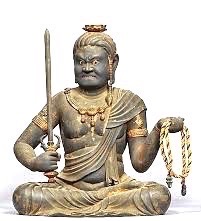
Fu-dō Myō-ō, 不動明王, No-move Bright-king, in Sanskrit, Acala, अचल, Immovable, is the leader of the various Myō-ō. He has a lotus flower on the top of his head, which represents the Sahasrara chakra, the thousand petal lotus of enlightenment. As the wrothful manifestation of Dainichi, Fudō carries in his right hand the Ku-ri ka-ra, 倶利伽羅, Both-advantage attend-spread-sword, representing wisdom cutting through ignorance, and holds a lasso in his left hand to catch and bind up demons. The etymology of the name comes from ‘unmoving guardian’, and with his loving yet angry expression and unwavering mind, he guides and protects all living beings. This is the guardian deity of the Asian zodiac for the Tori-doshi, 酉年, Cock-year. His location is in the West which is the sign of Da, 兌, Lake, and marked with the trigram ☱.
The full tatami where Tea utensils are arranged and where the teishu prepares the tea is called the dō-gu tatami, 道具畳, way-tool mat, and ten-mae-za, 点前座, offer-fore-seat. Its location in the yojōhan is in the West and Northwest area. The utensils are in the realm of Amida, and the area of teishu is in the realm of Fudō Myō-ō, who is the master of fire.
Combining trigrams Ken ☰ Heaven and Da ☱ Lake, create hexagram 10, ䷉, Ri, 履, Treading. This may be identified with the tatami that the teishu steps upon when entering the Tearoom, which is called a fumi-komi tatami, 踏込畳, step-onto tatami. An aspect of Chanoyu and its study is ri-reki, 履歴, perform-continuation, history, and is connected with the hexagram 10, ䷉, Ri, 履, Treading.
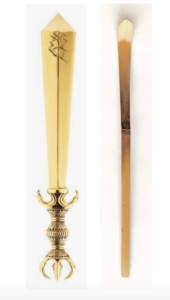
San-ko-ken, 三鈷剣, three-cobalt-sword, and bamboo cha-shaku, 茶杓, tea-scoop, with its tip called ken-saki, 剣先, sword-ahead.
In identifying the teishu as a representative of Fudō, the objects held by Fudō may be identified with the cha-dō-gu, 茶道具, tea-way-tools, held by the teishu. The sword, San-ko-ken, 三鈷剣, three-cobalt-sword, or the Buddhist Ku-ri-ka-ra ken, 倶利伽羅剣, Both-advantage-attend-spread-sword, is a blade believed to disperse evil and cut away peoples’ worldly desires. The sword may be identified with the cha-shaku, 茶杓, tea-scoop, which is purified with three strokes of the fuku-sa, 帛紗, cloth-gauze, and cuts into the tea powder. There are bamboo chashaku that have pointed ends, which are called ken-saki, 剣先, sword-ahead.
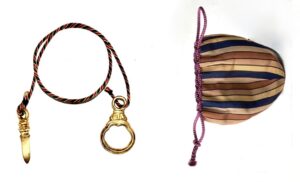
The golden blade and ring of the lasso may reflect the gold leaf underside of the chaire lid.
Fudō’s lasso, ken-jaku, 羂索, snare-cord, binds and unites, and is made of silk threads of five colors, with a metal loop and weight. The lasso may be identified with the cord of the shi-fuku, 仕覆, serve-cover, ‘Ao-ki Kan-tō’, 青木間道, Green-tree Interval-way. The cord binds the cloth together, and is made into a musubi, 結, knot.
For further study, see also: Charcoal: Sumi for Furo and Ro, Furo Ro:Three Forms, Furo to Ro, Ro: November Opening, Ro and the Goma, and Tokonom and Imae
Addendum: Diagram identifying the major deities and their realms in the Taizōkai Mandara.
